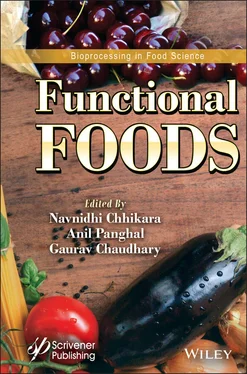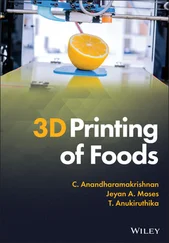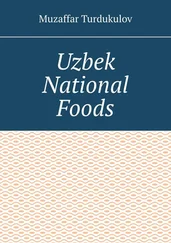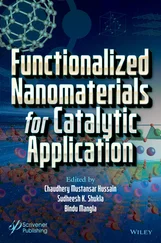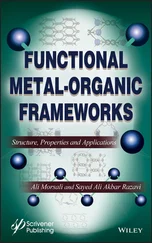Functional Foods
Здесь есть возможность читать онлайн «Functional Foods» — ознакомительный отрывок электронной книги совершенно бесплатно, а после прочтения отрывка купить полную версию. В некоторых случаях можно слушать аудио, скачать через торрент в формате fb2 и присутствует краткое содержание. Жанр: unrecognised, на английском языке. Описание произведения, (предисловие) а так же отзывы посетителей доступны на портале библиотеки ЛибКат.
- Название:Functional Foods
- Автор:
- Жанр:
- Год:неизвестен
- ISBN:нет данных
- Рейтинг книги:3 / 5. Голосов: 1
-
Избранное:Добавить в избранное
- Отзывы:
-
Ваша оценка:
- 60
- 1
- 2
- 3
- 4
- 5
Functional Foods: краткое содержание, описание и аннотация
Предлагаем к чтению аннотацию, описание, краткое содержание или предисловие (зависит от того, что написал сам автор книги «Functional Foods»). Если вы не нашли необходимую информацию о книге — напишите в комментариях, мы постараемся отыскать её.
Presenting cutting-edge information on new and emerging food engineering processes,
, the second volume in the groundbreaking new series, “Bioprocessing in Food Science,” is an essential reference on the modeling, quality, safety, and technologies associated with food processing operations today.
This outstanding new volume:
Audience: Functional Foods
Functional Foods — читать онлайн ознакомительный отрывок
Ниже представлен текст книги, разбитый по страницам. Система сохранения места последней прочитанной страницы, позволяет с удобством читать онлайн бесплатно книгу «Functional Foods», без необходимости каждый раз заново искать на чём Вы остановились. Поставьте закладку, и сможете в любой момент перейти на страницу, на которой закончили чтение.
Интервал:
Закладка:
Table of Contents
1 Cover
2 Title Page
3 Copyright
4 Preface
5 1 Overview of Functional Foods 1.1 Introduction 1.2 Functional Food History and Market 1.3 Classification of Functional Foods 1.4 Types of Functional Foods 1.5 Functional Foods and Health Claims 1.6 Conclusion References
6 2 Prebiotics and Synbiotics in Functional Foods 2.1 Introduction 2.2 Prebiotics 2.3 Prebiotic Dairy Functional Foods 2.4 Synbiotics 2.5 Synbiotic Dairy Functional Foods 2.6 Conclusions Acknowledgements References
7 3 Cereal-Based Functional Foods 3.1 Introduction 3.2 Structure and Chemical Composition of Cereal Grains 3.3 Functional Foods Produced from Cereal Grains 3.4 Conclusion References
8 4 Millet Based Functional Food 4.1 Introduction 4.2 Classification of Millets 4.3 Nutritional Importance of Major and Minor Millets 4.4 Grain Structure and Chemical Composition 4.5 Functional Compounds Present in Millets 4.6 Millet and Sorghum Based Commercial Products 4.7 Millet Based Functional Food Products 4.8 Health Benefits of Millet Based Functional Food 4.9 Future Aspects 4.10 Challenges 4.11 Conclusions References
9 5 Dairy Milk Based Functional Foods 5.1 Introduction 5.2 Functional Foods and Regulation 5.3 Functional Dairy Foods 5.4 Industrial Processing of Functional Dairy Products 5.5 Conclusions Acknowledgements References
10 6 Fruits and Vegetable Functional Foods 6.1 Introduction 6.2 Fruit and Vegetable as Functional Ingredients 6.3 Common Functional Compounds in Fruits and Vegetables 6.4 Physicochemical Treatments to Produce Fruit and Vegetable Based Ingredients 6.5 Main Technologies to Obtain Powder Ingredients from Fruits and Vegetable 6.6 Foods as Carriers of Bioactive Compounds from Fruits and Vegetable 6.7 Fruits and Vegetable By-Products as Functional Ingredients 6.8 Impact of Food Processing on the Biofunctional Properties 6.9 Concluding Remarks and Future Outlooks Acknowledgements References
11 7 Meat Based Functional Foods 7.1 Introduction 7.2 Meat Role in the Nourishments 7.3 Types of Meat 7.4 Benefits of Consuming Meat 7.5 Concept of Functional Foods 7.6 Creation of Functional Foods Based on Meat 7.7 Innovation of Technology for New Dietary Principles 7.8 Conclusion References
12 8 Seafood Based Functional Foods 8.1 Introduction 8.2 Fish Protein Hydrolysates 8.3 Fish Oil 8.4 Chitin 8.5 Fish Roe 8.6 Gelatine 8.7 Conclusions References
13 9 Millet Based Functional Foods: Bio-Chemical and Bio-Functional Properties 9.1 Introduction 9.2 Recent Developments on Millet Based Functional Foods 9.3 Millet Nutrition Profile 9.4 Bioactivities of the Millet Based Functional Foods Compounds 9.5 Biomedicinal and Health Potential of Millet-Based Foods 9.6 Conclusion References
14 10 Mushroom as a Source of Fungal Based Functional Foods 10.1 Introduction 10.2 Life Cycle of Mushroom 10.3 Different Types of Mushroom Cultivation Process 10.4 Traditional and Valorised Substrates Used for Cultivation of Mushroom Under SSF Process 10.5 Challenges of Mushroom Cultivation and Upcoming Strategies 10.6 Mycelium Physiology 10.7 Mushroom Mycelium Cultivation Status 10.8 Enhancement of Nutritional and Therapeutic Attributes Present in Mycelium and Mushroom 10.9 Nutraceuticals Compounds Present in Mycelium and Mushroom Along with their Therapeutic Effects 10.10 Food Products Developed from Mushroom Mycelium and Fruit-Bodies 10.11 Umami Flavour Extracted from Mushroom Mycelium and Fruit-Bodies 10.12 Conclusion References
15 11 Probiotics and Prebiotics as Functional Foods 11.1 Introduction 11.2 Immunity of the Gut and its Connection to Microbes 11.3 An Overview of Functional Foods 11.4 Critical Evaluations on Probiotics and Prebiotics 11.5 Conclusions References
16 12 Food Function and Health Benefits of Functional Foods 12.1 Introduction 12.2 Functional Foods Terminology and Definition 12.3 Constituents in Functional Foods 12.4 Bioactive Compounds in Functional Foods 12.5 Health Benefits 12.6 Sources of Functional Foods 12.7 Effect of Processing on Functional Products 12.8 Present Status and Future Aspects 12.9 Conclusion References
17 13 Double Emulsion for Controlled Delivery of Functional Food Ingredients 13.1 Introduction 13.2 Double Emulsion Formation Mechanism 13.3 Types of Functional Ingredient for Delivery 13.4 Double Emulsion Particle Specification 13.5 Double Emulsion Stability 13.6 Release Characteristics 13.7 Gastrointestinal Properties 13.8 Conclusion References
18 14 Use of Biopolymers for Packaging of Functional Foods 14.1 Introduction 14.2 Applications of Biopolymers in Scientific Fields 14.3 Food Product Processing 14.4 Use of Biopolymers for Packaging of Functional Foods 14.5 Biopolymers Used for Processing of Functional Foods 14.6 Conclusion References
19 15 Global Concepts and Regulations in Functional Foods 15.1 Introduction 15.2 Regulatory Framework of Functional Foods 15.3 Conclusions Acknowledgements References
20 Index
21 End User License Agreement
List of Illustrations
1 Chapter 2 Figure 2.1 Health effects of orally administered prebiotic substrates. Adapted f... Figure 2.2 Mechanism of action of a complementary synbiotic. Figure 2.3 Mechanism of action of a synergistic synbiotic. Figure 2.4 Synbiotics health benefits tested with human trials. Adapted from Swa...
2 Chapter 4 Figure 4.1 Sorghum grain and its anatomical parts. Figure 4.2 Millet grain and its anatomical parts.Figure 4.3 Schematic representation of phytic acid.Figure 4.4 Structure of arabino-xylo-oligosaccharides from wheat bran hemicellul...Figure 4.5 Applications of xylo-oligosaccharides (XOs).Figure 4.6 Gluten-free products market, by region (USD million) from 2016-2023.Figure 4.7 Major beverage sectors and segments throughout the world.
3 Chapter 5Figure 5.1 Main mechanisms of action of probiotics.Figure 5.2 Selection criteria for a prebiotic as a food ingredient [64, 65].Figure 5.3 Mechanism of action of prebiotics and probiotics in the body [60, 62]...Figure 5.4 Some applications of prebiotics in dairy products [67].Figure 5.5 Processing of functional dairy products.
4 Chapter 8Figure 8.1 Steps involved in preparation of fish protein hydrolysates.Figure 8.2 Steps involved in preparation of fish crude oil.Figure 8.3 Various stages involved in obtaining refined fish oil.Figure 8.4 Extraction of chitin.Figure 8.5 Various processing methods of fish roe protein concentrates.
5 Chapter 9Figure 9.1 The world millet production by country in 1000 MT [10, 15].
6 Chapter 10Figure 10.1 Different stages of mushroom life cycle [14].Figure 10.2 Physiological structure of mycelium (schematic representation) adopt...Figure 10.3 A possible mechanism for ergosterol induced antitumor activity again...
7 Chapter 11Figure 11.1 Action mechanisms of probiotics. Probiotics offer several means of b...Figure 11.2 Action mechanisms of prebiotics. Upon selective utilization of prebi...
8 Chapter 13Figure 13.1 Double emulsion (water-in-oil-in-water) structure [2].Figure 13.2 Conventional method of double emulsion formation [17].Figure 13.3 Double emulsion physical instability mechanism.Figure 13.4 Mechanism of active molecule release.
9 Chapter 14Figure 14.1 Chemical structures of biopolymers used in functional food packaging...Figure 14.2 Limitations of conventional food packaging materials.
List of Tables
1 Chapter 1 Table 1.1 Different commercial functional foods available in the global market.
2 Chapter 2 Table 2.1 Potential beneficial effects of ingredients and functional compounds o... Table 2.2 Prebiotic substances, their source, and structure. Adapted from Sako a... Table 2.3 Some examples of the application of prebiotic agents in fermented milk... Table 2.4 Examples of synbiotic dairy products. Adapted from Dantas et al. [47].
Читать дальшеИнтервал:
Закладка:
Похожие книги на «Functional Foods»
Представляем Вашему вниманию похожие книги на «Functional Foods» списком для выбора. Мы отобрали схожую по названию и смыслу литературу в надежде предоставить читателям больше вариантов отыскать новые, интересные, ещё непрочитанные произведения.
Обсуждение, отзывы о книге «Functional Foods» и просто собственные мнения читателей. Оставьте ваши комментарии, напишите, что Вы думаете о произведении, его смысле или главных героях. Укажите что конкретно понравилось, а что нет, и почему Вы так считаете.
